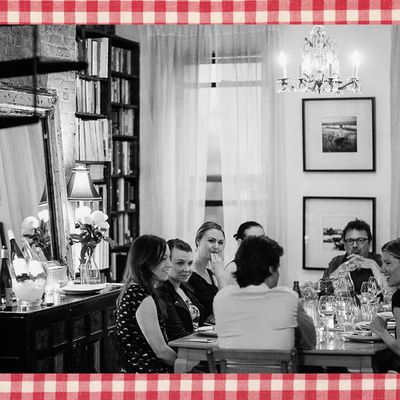
A weeklong series on the art of entertaining, for women who are too busy for Pinterest.
In this era of cultural casualness, the idea of seating arrangements can seem archaic. We’re more used to mingling at cocktail parties, or plopping down wherever we want at sitdown dinners. And in small city apartments, often there aren’t enough seats, period — never mind assigned ones.
I’ve thrown many a dinner party (in a small, fifth-floor walk-up apartment!) and I can confidently say that the best ones — by far — are the ones where I assign seats. There was the Monday-night dinner where the majority of the guests — total strangers before — went out for drinks afterward after bonding over lemony roast chicken, spring-pea risotto, and a magnum of rosé. Or the storytelling dinner (again with friends who didn’t know each other at the onset) that lasted until 1 a.m. because everyone wanted to keep gabbing on about accidental proposals and near-kidnappings. Or the Thanksgiving when a normally quite serious friend of mine nearly spit his drink out onto the table because he was laughing so hard (at an Italian guest who was complaining that he never got “rogered” anymore).
Maybe this makes me a control freak, but I like to think of a seating chart as insurance against a boring party. A good dinner party doesn’t have to be elaborate or expensive — in fact, the best ones are often quite simple. At the end of the day, it’s not the food and the table that your guests are going to remember, it’s how they felt, and the conversations they had.
With a seating arrangement, you spare your guests from awkward high-school flashbacks — no one wants to relive the intricate politics of cafeteria cliquishness. And when you tell people where to sit, you’re relieving them of yet another decision. We’re all busy people. Better to just turn off your brain, find your name card, and sit down.
At its core, assigned seating creates a sense of calm for you, the host, and a bit of mystery for them, the guest. Who am I sitting next to? My future spouse? A new business partner? A BFF? And yes, I have arranged at least one marriage this way.
Of course, it takes skill, dexterity, and practice to master the seating chart. I swear by this five-step formula:
1. Create a good guest list. A dinner party is only as fun as the people around the table. I like to make sure a good mixture of industries are represented; a recent dinner included a fashion designer, a movie stuntman, a tech entrepreneur, a food writer, and a photographer. As long as everyone enjoys good conversation and meeting new people, it’ll be fun — I guarantee it.
2. Mix up the quiet folks and more lively ones. As a hostess, it’s my job to make sure everyone feels comfortable and has a good time. I always spend time thinking about the dynamic I want to create around the table — who’s going to enjoy talking to whom, who’s quiet and who’s more lively — and seat people accordingly. Anchor each end of the table with someone extra gregarious to ensure that the conversation flows.
3. Alternate men and women. At my dinner parties, I alternate the girls and guys, and mix up single and married people. I lived in France for a few years, and at their dinner parties they always separate married couples. Their philosophy is: If you’re married to the person, why should you spend a dinner party talking to them? I haven’t yet adopted that policy in full (yet!), but it’s another way to create an interesting dynamic.
4. Seat old friends next to new ones. I like to put people next to at least one person they know, and one person they don’t. A couple of Thanksgivings ago, a childhood friend of mine joined; she didn’t know anyone else, so I sat her next to me. She still met plenty of new people, but I wanted to make sure she didn’t feel totally overwhelmed.
5. Create handwritten name cards. It’s a nice touch. They can be written on index cards or newspaper — it doesn’t have to be something Pinterest-y. I love buying little luggage tags — you can get them at any stationery store — to use as name cards, and tie them around the napkins with a piece of twine. Okay, so maybe that sounds a little Pinterest-y, but I can promise that your guests will appreciate the extra effort.





